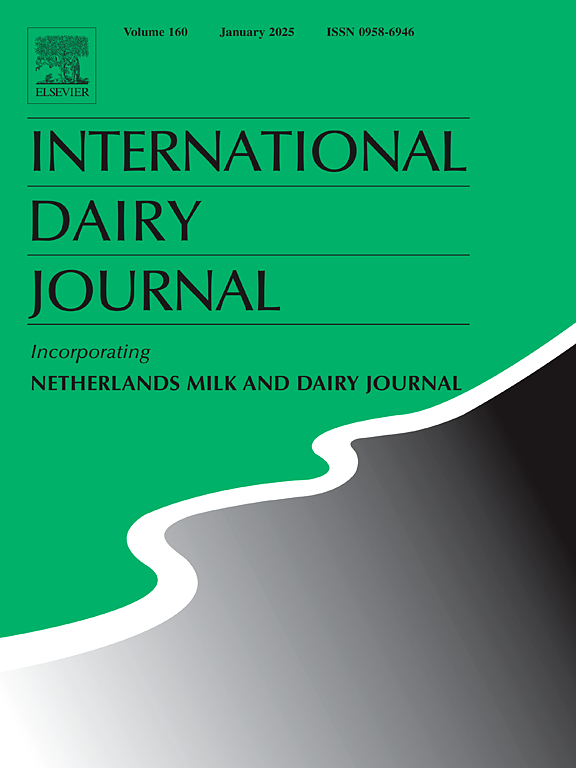从羊奶中分离的铜绿假单胞菌的高腐败潜势和多药耐药性
IF 3.1
3区 农林科学
Q2 FOOD SCIENCE & TECHNOLOGY
引用次数: 0
摘要
本研究的目的是评估从冷冻生羊奶中分离的铜绿假单胞菌(P. aeruginosa)的脂蛋白水解腐败潜力和耐药性。将收集的样品在9°C下保存72 h后,在假单胞菌琼脂基上用头孢啶酮、头孢啶酮、头孢啶酮(25°C/48 h)进行镀膜。聚合酶链反应证实菌株为假单胞菌属、铜绿假单胞菌属和aprX基因的存在。使用Milk agar和Tributyrin agar Base(21°C/72 h)进行腐败能力(存在或不存在)和潜力(琼脂上脂解和/或蛋白解光晕的大小)。采用圆盘扩散法(35℃/18 h)测定药敏。共分离出假单胞菌178株,其中铜绿假单胞菌占13%(23株)。其中,96.65%表达了脂蛋白分解能力,这表明乳制品的质量可能存在问题。就腐败潜力而言,蛋白质水解活性占主导地位。所有铜绿假单胞菌株均携带aprX基因。P. aeruginosa对哌西林-他唑巴坦(100%)、庆大霉素(100%)、阿米卡星(100%)、环丙沙星(100%)、亚胺培南(91.3%)、左氧氟沙星(86.9%)、甲氧苄啶(86.9%)、四环素(82.6%)、氯霉素(52.1%)敏感。对氨苄西林(95.6%)、红霉素(95.6%)、头孢他嗪(78.2%)和氨曲南(47.82%)耐药。此外,19株铜绿假单胞菌出现多药耐药。这些结果强调了铜绿假单胞菌控制在绵羊奶业中的重要性,因为这些微生物具有高腐败潜力,具有蛋白质水解优势和多药耐药性,是重要的公共卫生问题。本文章由计算机程序翻译,如有差异,请以英文原文为准。
High spoilage potential and multidrug resistance of P. aeruginosa strains isolated from sheep milk
The aim of this study was to evaluate the lipoproteolytic spoilage potential and the antimicrobial resistance profile of P. aeruginosa strains isolated from refrigerated raw sheep milk. After keeping the collected samples at 9 °C for 72 h, they were plated on Pseudomonas Agar Base with Cetrimide, Fucidin, Cephalothin (25 °C/48 h). The genus Pseudomonas spp., the species P. aeruginosa and the presence of the aprX gene were confirmed by polymerase chain reaction. The spoilage capacity (presence or absence) and potential (size of lipolysis and/or proteolysis halos on agar) were performed using Milk Agar and Tributyrin Agar Base (21 °C/72 h). Antimicrobial susceptibility was determined using the disc diffusion method (35 °C/18 h). A total of 178 strains of Pseudomonas spp. were isolated, of which 13 % (23) were P. aeruginosa. Of these, 96.65 % expressed lipoproteolytic capacity, which points to a possible problem in the quality of dairy products. In terms of spoilage potential, proteolytic activity was predominant. All P. aeruginosa strains carried the aprX gene. P. aeruginosa were susceptible to piperacillin-tazobactam (100 %), gentamicin (100 %), amikacin (100 %), ciprofloxacin (100 %), imipenem (91.3 %), levoflaxacin (86.9 %), trimethoprim (86.9 %), tetracycline (82.6 %), chloramphenicol (52.1 %). The isolated strains were resistant to ampicillin (95.6 %), erythromycin (95.6 %), ceftazidine (78.2 %) and aztreonam (47.82 %). In addition, 19 P. aeruginosa strains showed multidrug resistance. These results highlight the importance of P. aeruginosa control in the sheep dairy industry, as these microorganisms exhibit high spoilage potential with proteolytic predominance and multidrug resistance, which are important public health issues.
求助全文
通过发布文献求助,成功后即可免费获取论文全文。
去求助
来源期刊

International Dairy Journal
工程技术-食品科技
CiteScore
6.50
自引率
9.70%
发文量
200
审稿时长
49 days
期刊介绍:
The International Dairy Journal publishes significant advancements in dairy science and technology in the form of research articles and critical reviews that are of relevance to the broader international dairy community. Within this scope, research on the science and technology of milk and dairy products and the nutritional and health aspects of dairy foods are included; the journal pays particular attention to applied research and its interface with the dairy industry.
The journal''s coverage includes the following, where directly applicable to dairy science and technology:
• Chemistry and physico-chemical properties of milk constituents
• Microbiology, food safety, enzymology, biotechnology
• Processing and engineering
• Emulsion science, food structure, and texture
• Raw material quality and effect on relevant products
• Flavour and off-flavour development
• Technological functionality and applications of dairy ingredients
• Sensory and consumer sciences
• Nutrition and substantiation of human health implications of milk components or dairy products
International Dairy Journal does not publish papers related to milk production, animal health and other aspects of on-farm milk production unless there is a clear relationship to dairy technology, human health or final product quality.
 求助内容:
求助内容: 应助结果提醒方式:
应助结果提醒方式:


